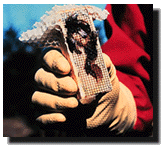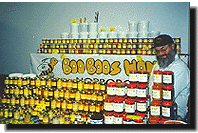
Beekeeping represents a small portion of Prince Edward Island’s agricultural production. However, it plays an interesting role, in symbiotic relationship with the production of field crops. Today, the province has about five major producers keeping 75 to 500 hives. Approximately thirty to forty hobbyists keep between one and ten hives. Most producers sell to local markets and supply about half of the honey sold on the Island.
Over the past years, beekeepers have been experiencing the same changes felt throughout the agricultural sector. Operations are being forced to streamline production and increase efficiency in order to remain profitable. Beekeeping entails high costs. Packages of: bees are purchased from New Zealand at $150 each. The producer must also account for feeders, medications, labour, machinery for mixing the syrup, and packing to wrap the hives. As a result of the high costs of production, the number of producers is diminishing while the remaining operations are of larger size.
Boo Boos Honey, owned and operated
by Allen Picketts, is a beekeeping operation located a
short distance from Kensington. Beekeeping activities at
Boo Boos Honey go through a number of stages through the
course of a year. The winter months are spent building
and repairing  hives in preparation for the coming
season. In spring, the winter hives are unpacked, dead
hives removed, bottom boards cleaned, and the surviving
hives equalized so that they have equal numbers of bees.
Imported packages of bees are brought in at this time and
moved into their new hives. During these early months,
the bees must be fed pollen cakes and sugar syrup to
stimulate brood rearing. The hives must be as strong as
possible for the productive summer months.
hives in preparation for the coming
season. In spring, the winter hives are unpacked, dead
hives removed, bottom boards cleaned, and the surviving
hives equalized so that they have equal numbers of bees.
Imported packages of bees are brought in at this time and
moved into their new hives. During these early months,
the bees must be fed pollen cakes and sugar syrup to
stimulate brood rearing. The hives must be as strong as
possible for the productive summer months.
A hive consists of a stack of four or more bottomless boxes, closed off with boards on the top and under the bottom boxes. The two bottom-most boxes are the brood chambers, where the bees live. When the honey flow starts, the bees put the excess honey in the boxes above the brood chambers. The boxes contain a series of combs, which the bees fill with wax and honey. The beekeeper adds new boxes containing fresh combs as required.
On June 1, Allen Picketts rents out his hives to other
farmers to pollinate the plants in  their blueberry fields. Blueberry
pollination usually lasts three weeks. At the end of this
period, the honeycombs filled during the blueberry
pollination are removed and kept separate so that he can
package a distinctive blueberry honey that will have a
subtly different taste from honey produced from
pollinating other plants. Other producers generally leave
the blueberry honey in the hive and end up with a uniform
honey product at the end of the season.
their blueberry fields. Blueberry
pollination usually lasts three weeks. At the end of this
period, the honeycombs filled during the blueberry
pollination are removed and kept separate so that he can
package a distinctive blueberry honey that will have a
subtly different taste from honey produced from
pollinating other plants. Other producers generally leave
the blueberry honey in the hive and end up with a uniform
honey product at the end of the season.
For the rest of the summer, the bees are brought to clover fields. The hives also spend some time on fields of sunflowers, turnip fields, raspberries, and goldenrod fields. Again, Boo Boos Honey keeps this honey separate to produce the unique, source-named honeys for which it is famous. Once filtered and packaged, the honey is sold in one of three manners. The most lucrative is the direct retail market, in which the product is sold directly to the consumer. To complement these sales, Boo Boos Honey sells at farmers’ markets and craft fairs, successfully building personal recognition and a reputation for quality among new and returning buyers. The second market is wholesale, where grocery stores or bakeries buy large quantities of honey for individual sale to consumers or for use in baked goods. Thirdly, producers sell in bulk to other beekeepers or packagers to supplement their production.
Potatoes | Fruits and Vegetables |
Field Crops | Beef and Dairy
Swine | Poultry and Eggs | Emerging Commodities
